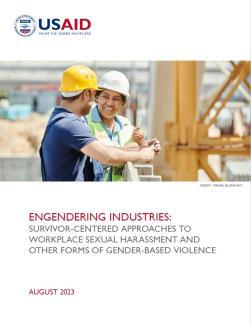Survivor-Centered Approaches Guide
Survivor-centered approaches to workplace sexual harassment and other forms of gender-based violence
English | Español | Français | Arabic
This guide supports organizations to use survivor-centered approaches in preventing, addressing, and responding to workplace gender-based violence (GBV), including sexual harassment.
Eighty-five percent of women have experienced sexual harassment in the workplace, a persistent trend that is especially prevalent in male-dominated industries. However, only seven percent of victims report the harassment showing a general distrust and a lack of confidence in traditional grievance handling and reporting processes. Sexual harassment and other forms of gender-based violence (GBV) reduce employee satisfaction, morale, and productivity. When sexual harassment occurs within a team, companies lose an estimated $22,500 in productivity per harassed individual. However, companies that use survivor-centered approaches and create safe and violence-free workplaces perform better across several business metrics. These organizations achieve higher productivity, lower turnover, stronger company brand and reputation, and increased ability to attract and retain top talent.
The United States Agency for International Development’s (USAID) Engendering Industries program supports organizations to use survivor-centered approaches in preventing, addressing, and responding to workplace gender-based violence (GBV), including sexual harassment. This guide:
- Articulates the business case for preventing and responding to workplace sexual harassment and GBV.
- Provides an overview of behaviors that constitute sexual harassment and GBV.
- Illustrates survivor-centered approaches to workplace sexual harassment and other forms of GBV.
Senior leaders, managers, human resources professionals, and diversity, equity, inclusion, and accessibility staff should use this guide in developing and implementing workplace sexual harassment and GBV policies.
About Engendering Industries
Launched in 2015, USAID’s Engendering Industries program supports organizations in developing countries to increase economic opportunities for women and improve gender equality in the workplace. Expanding women’s participation in male-dominated sectors leads to tangible economic empowerment outcomes for women, such as formal employment opportunities and higher income. Increased gender equality also improves an organization’s business performance, helping companies meet their bottom-line by enhancing employee satisfaction, reducing turnover, and driving productivity. Well-functioning organizations are also vital in supporting stronger and more resilient economies. Through a customized best practices framework, demand-driven coaching, and a Gender Equity Executive Leadership Program, Engendering Industries builds the capacity of leaders to implement gender equality interventions that increase the professional participation of women and improve business performance.


